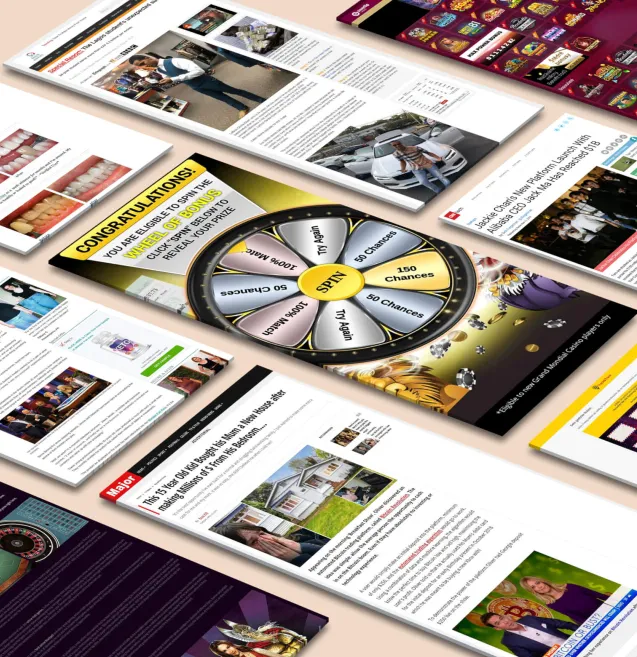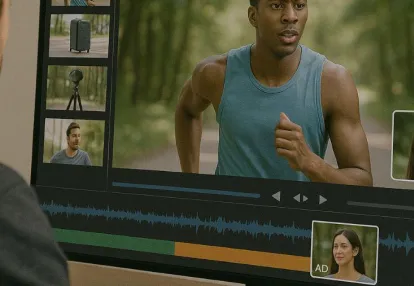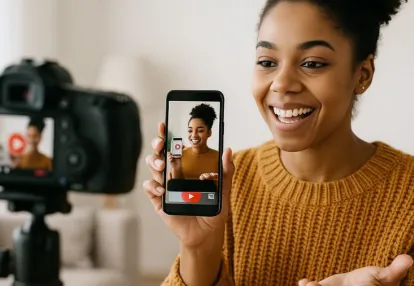
Наши инструменты отслеживают миллионы TikTok-объявлений из более чем 55 стран. Крупнейшая библиотека TikTok-рекламы в сфере e-commerce и мобильных приложений!
Попробуйте БЕСПЛАТНОIn-stream ads are video advertisements that play before, during, or after your streaming content on platforms like YouTube, OTT services, and social media channels. These ads represent a critical revenue stream in digital advertising, particularly as more viewers shift from traditional TV to streaming platforms. You're essentially capturing your audience's attention while they're already engaged with video content—making it one of the most effective advertising formats available today.
Ad retention determines whether your advertising investment actually pays off. When viewers watch your in-stream ads through to completion, you're not just increasing brand awareness—you're directly impacting the success of AVOD platforms and your campaign ROI. High retention rates translate to better engagement metrics, improved conversion rates, and ultimately, more revenue for both advertisers and content platforms.
The challenge? Most in-stream ads struggle with viewer drop-off. You might have a compelling message, but if your editing doesn't support viewer engagement, you're losing potential customers within the first few seconds.
This article breaks down 5 editing techniques to improve in-stream ad retention that you can implement immediately:
These video editing techniques for ads will help you transform viewer engagement and maximize your advertising impact.
Ad retention factors determine whether viewers stay engaged with your in-stream advertisements or abandon them entirely. You need to understand these core elements to create ads that hold attention and drive results.
Three primary factors shape retention rates:
Viewer drop-off accelerates rapidly when technical issues plague your ads. A study of AVOD platforms revealed that buffering delays beyond three seconds trigger abandonment rates exceeding 40%. Poor video quality, distorted audio, or laggy playback signals low production value and damages brand perception.
The impact extends beyond single impressions. Repeated exposure to poorly executed ads trains viewers to skip automatically, reducing the effectiveness of future campaigns. You're essentially conditioning your audience to disengage.
Audience-centric strategies flip this dynamic by prioritizing viewer needs. Instead of forcing ads into content breaks, you analyze viewing patterns to identify natural pause points. You test different ad lengths against engagement metrics. You personalize ad content based on viewer preferences and behavior.
Boost engagement in InStream ads by treating retention as a continuous optimization process rather than a one-time creative decision.
The opening seconds of your in-stream ad determine whether viewers stay engaged or reach for the skip button. Research shows you have approximately 3-5 seconds to capture viewer attention before drop-off rates spike dramatically. This narrow window demands strategic editing choices that immediately communicate value and intrigue.
An effective ad hook works by triggering curiosity, emotion, or recognition instantly. Consider how Dollar Shave Club's viral ad opened with "Our blades are f***ing great"—a bold statement that stopped scrollers mid-feed. Similarly, Apple's product launches often begin with extreme close-ups of sleek hardware, letting visual appeal speak before any narration begins. These approaches share a common thread: they deliver immediate impact without requiring context.
Creating dynamic openings requires specific editing techniques:
The editing rhythm matters as much as the content itself. Quick cuts, punchy sound design, and visual contrast between frames create momentum that pulls viewers forward. You're not just showing information—you're creating an experience that makes stopping feel impossible.
Ad length optimization directly impacts whether viewers stay engaged or hit the skip button. You need to match your ad duration to the platform and placement—15-second pre-rolls work differently than 30-second mid-rolls. The sweet spot varies, but data consistently shows that ads exceeding 30 seconds see significant drop-off rates unless the content justifies the extended runtime.
For instance, 15-second pre-rolls have shown to be effective on platforms like TikTok, where quick engagement is key.
Pacing in video ads determines how information flows to your audience. You can't dump all your messaging in the first five seconds and expect viewers to stick around for filler content. Strategic pacing distributes key messages throughout the ad, creating multiple engagement peaks that improve ad watch time. I've seen ads that feel like 15 seconds but actually run 25 because the editing maintains momentum.
Your editing choices shape perceived duration more than the actual timestamp. Quick cuts between scenes create energy and compress time psychologically. Varying shot lengths—mixing two-second cuts with four-second holds—establishes rhythm that keeps eyes on screen. You want viewers thinking "that was quick" rather than checking how many seconds remain.
Consider these editing techniques for optimal pacing:
The goal isn't just shorter ads—it's making every second count toward viewer retention through deliberate pacing decisions.
Seamless transitions are the invisible threads that hold your in-stream ad together. When you cut from one scene to another without jarring your viewers, you're reducing the mental effort required to process your message. This visual continuity keeps people watching instead of reaching for the skip button.
I've tested countless ad variations, and the difference between choppy cuts and smooth editing is measurable in retention metrics. Your brain processes visual information constantly, and when transitions feel natural, viewers stay immersed in your narrative.
You can maintain visual flow through several editing approaches:
The cognitive load on your viewers decreases significantly when each frame logically connects to the next. You're essentially creating a visual conversation that feels effortless to follow.
Smooth editing doesn't mean slow or boring. You can maintain energy while preserving flow by matching the rhythm of your cuts to the emotional beat of your message. Quick cuts work when they follow a pattern; random, disconnected jumps push viewers away. Your transitions should feel intentional, guiding attention rather than demanding it.
Branding in ads requires a delicate balance—you want viewers to remember your brand without feeling like they're watching a hard sell. The key is weaving brand elements into your narrative so naturally that they enhance rather than interrupt the viewing experience.
Subtle branding starts with strategic placement. You can integrate your logo in the lower third of the frame during key moments, or incorporate brand colors into the scene's lighting and props. I've found that matching your brand's visual identity to the emotional tone of the ad creates stronger connections than forcing logos into every frame.
Your editing choices directly impact brand recall. Consider these approaches:
The editing rhythm itself can reinforce brand identity. If your brand represents energy and innovation, use quicker cuts and dynamic camera movements. For luxury brands, longer takes and smoother transitions communicate sophistication.
You'll notice the most effective ads treat branding as part of the storytelling fabric. When viewers engage with your narrative first and absorb brand elements subconsciously, they develop stronger associations. This approach builds long-term engagement because audiences don't feel manipulated—they feel entertained while naturally absorbing your brand message through carefully crafted visual and auditory cues.
Analytics for video ads change the way you do creative editing for video ads by giving you clear evidence of what works and what doesn't. You can track where viewers stop watching, when they get really interested, and how many people finish watching to figure out exactly where your edits need improvement. This way of using data takes away the guesswork from your editing choices.
Insights in real-time let you keep an eye on performance metrics as viewers interact with your in-stream ads. You'll find out which scenes grab attention, where viewers watch certain parts again, and when they skip ahead. Tools like Google Analytics 4, Facebook Ads Manager, and specialized video analytics platforms such as Vidyard or Wistia offer detailed information on how viewers behave.
A/B testing different cuts becomes your most powerful optimization technique. You can test:
The beauty of A/B testing lies in its objectivity—you're not relying on opinions but on actual viewer responses. When you test two versions of the same ad with slight editing variations, the data reveals which version drives better retention and engagement.
Tools like Adobe Premiere Pro now work together with analytics platforms, allowing you to make informed editing changes based on performance data. You can find out which parts are not doing well and re-edit them specifically to fix retention problems, creating a continuous cycle of improvement that keeps your in-stream ads performing at their best.
Platform tailored content requires you to understand the unique viewing behaviors and technical specifications of each distribution channel. YouTube viewers expect polished, longer-form content with strong storytelling arcs. To achieve this, consider implementing some of these advanced YouTube video editing techniques that can help boost viewer retention. On the other hand, TikTok demands immediate visual impact within the first second. Instagram users scroll rapidly through their feeds, which means your edits need to prioritize vertical formatting and text overlays that work without sound.
OTT advertising presents distinct editing challenges compared to social media platforms. Connected TV viewers watch on larger screens from greater distances, requiring you to use wider shots and larger text elements for readability. You'll want to avoid rapid cuts that work well on mobile but feel jarring on a 55-inch television screen.
Pre-roll formats give you the luxury of viewer attention from the start, allowing for slightly longer brand introductions. Mid-roll placements interrupt content consumption, demanding tighter edits that respect the viewer's desire to return to their chosen content. Post-roll ads face the highest abandonment risk, requiring you to front-load your most compelling visuals and messaging.
Social media ads need device-specific optimization. Mobile viewers hold phones vertically 94% of the time, making 9:16 aspect ratios essential for Instagram Stories and TikTok. Desktop viewers on YouTube prefer 16:9 horizontal formats. You should create multiple edit versions of the same ad, adjusting composition, text size, and pacing to match each viewing context and device type.
Improving in-stream ad retention requires more than just individual tactics—you need a comprehensive strategy that combines creative editing, strategic placement, and data-driven insights. The 5 editing techniques to improve InStream ad retention we've discussed provide a framework, but their true effectiveness comes when you combine them with platform-specific customization and ongoing analytics monitoring.
Your video ad success strategies should evolve with your audience. Test different cuts, analyze engagement patterns, and refine your approach based on real viewer behavior. The advertisers who consistently optimize their in-stream ads—adjusting hooks, pacing, transitions, branding, and data insights—are the ones who build lasting viewer relationships and maximize AVOD platform performance. Start implementing these techniques today, measure your results, and keep iterating.
Получайте лучшие конверсионные лендинги каждую неделю на свою почту.
Советы и хитрости
Dan Smith
7 миннояб. 11, 2025
Объявление
Измерение показателя просмотра видео до конца стало определяющим критерием, разделяющим успешные видеокампании и те, которые не достигают цели в 2025 году. Показатель просмотра видео до конца (WTR) точно показывает, какой процент зрителей вашего видео действительно досмотрел его до конца, а не просто нажал кнопку воспроизведения и пролистал через три секунды.
Priya Kapoor
7 миннояб. 5, 2025
Самое читаемое
Контент, созданный пользователями (UGC), обозначает любой контент — видео, изображения, отзывы или рекомендации, — созданный обычными потребителями, а не брендами. Видеореклама InStream — это видеореклама, которая воспроизводится до, во время или после потокового контента на таких платформах, как YouTube, TikTok и Facebook.
Elena Morales
7 минокт. 30, 2025




